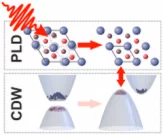The authors find using resonant and non-resonant x-ray diffraction on an x-ray free electron laser that the structural distortion and the underlying electronic structure of the charge density wave in TiSe2 show different energetics at ultrafast timescales. This indicates that the lattice distortion stabilizes the charge density wave.
It is commonly assumed that electronic phenomena occur at faster time scales than structural rearrangements. Here, we show the opposite: weak electronic excitations induce atomic displacements that outpace purely electronic charge carrier-interactions and hence are the dominant contribution in melting of the charge-density wave (CDW) in TiSe2. This divergence of electronic and structural order is directly observed in experimental data from a transient ultrafast resonant/non-resonant X-Ray diffraction experiment. Our results create a paradigm shift that constitute a different, mechanistic pathway for phase transitions in the ultrafast regime.
Contact
Dr Urs Staub
Microscopy and Magnetism Group
Paul Scherrer Institute, Forschungsstrasse 111, 5232 Villigen PSI, Switzerland
Telephone: +41 56 310 44 94
E-mail: urs.staub@psi.ch
Original Publication
Structural involvement in the melting of the charge density wave in 1T−TiSe2
Max Burian, Michael Porer, Jose R. L. Mardegan, Vincent Esposito, Sergii Parchenko, Bulat Burganov, Namrata Gurung, Mahesh Ramakrishnan, Valerio Scagnoli, Hiroki Ueda, Sonia Francoual, Federica Fabrizi, Yoshikazu Tanaka, Tadashi Togashi, Yuya Kubota, Makina Yabashi, Kai Rossnagel, Steven L. Johnson, and Urs Staub
Phys. Rev. Research 3, 013128 – Published 10 February 2021
DOI: 10.1103/PhysRevResearch.3.013128

